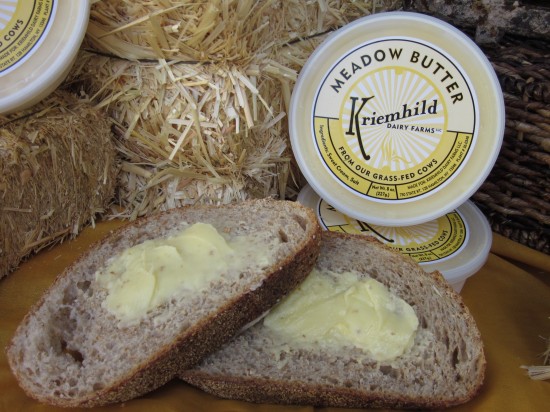 Our brand new Dairy Issue includes a profile of Kriemhild Dairy’s incredible Meadow Butter, made by a cooperative of four farmers who raise their cows on excellent pasture. The group currently sells their wonderful milk to the commodity market, but turns some of the cream into this nutty, rich and golden yellow boutique butter, now available at specialty food shops in the borough. (They hope to one day make creme fraiche, too.) Reporting out the story, we asked Lindsey McDonnell, the Agricultural Economic Development Specialist Assistant up in Madison County, a little about dairy farming and the commodity market. Her answers were so interesting (to food and agriculture nerds such as ourselves, that is) we’d thought we share:
Our brand new Dairy Issue includes a profile of Kriemhild Dairy’s incredible Meadow Butter, made by a cooperative of four farmers who raise their cows on excellent pasture. The group currently sells their wonderful milk to the commodity market, but turns some of the cream into this nutty, rich and golden yellow boutique butter, now available at specialty food shops in the borough. (They hope to one day make creme fraiche, too.) Reporting out the story, we asked Lindsey McDonnell, the Agricultural Economic Development Specialist Assistant up in Madison County, a little about dairy farming and the commodity market. Her answers were so interesting (to food and agriculture nerds such as ourselves, that is) we’d thought we share:
1. During what months is buttermaking on hiatus over the winter?
LM: The butter production ends typically in October and resumes again in May (spring butter is the best due to the vigourous growth in the pastures, which you’ll also see in the color of the butter). As a side note, traditional creameries will add food coloring to the butter to keep the color consistent for consumers. That does not happen with Meadow Butter–in fact, you’ll see a range of colors from deep golden in the spring (a reflection of the quality of grass) to a pale yellow cream in the fall.
2. How is the conventional dairy model different from what Kriemhild farmers do now?
LM: A majority of dairy farms in NYS and the northeast are conventional tie-stall dairies with the Holstein breed of cow, which as you indicated, do typically produce higher volumes [of milk], although many farmers will argue their quality of milk is just as good. [One of the Kriemhild farmers] has a mixed breed herd with an Ayrshire and Jersey breed base. These breeds don’t produce as much volume as a Holstein, but their milk is higher in butter fat and proteins. Additionally, while [this] milk is produced using natural inputs, there is no infrastructure [in place to sell] his unique milk, which is [usually] sold on the commodity market, another reason for value-added production–to get a fair price for the quality of milk he’s producing.
The dairy industry is very complex and nearly impossible to change in regards to pricing. Farmers have no control over milk prices which can change drastically, compared to the cost of inputs in producing milk. For example, say [a dairy farmer] produces 6 million pounds of milk/year and the price drops just $1, he’s out $60,000 with no possibility of reducing his inputs. The cooperative decided to go with a value added product, butter, to diversify their own businesses so that if there was a signifcant decrease in milk prices, they would still have some stability with the butter.
For more about Kriemhild Dairy and Meadow Butter, read the story here.



